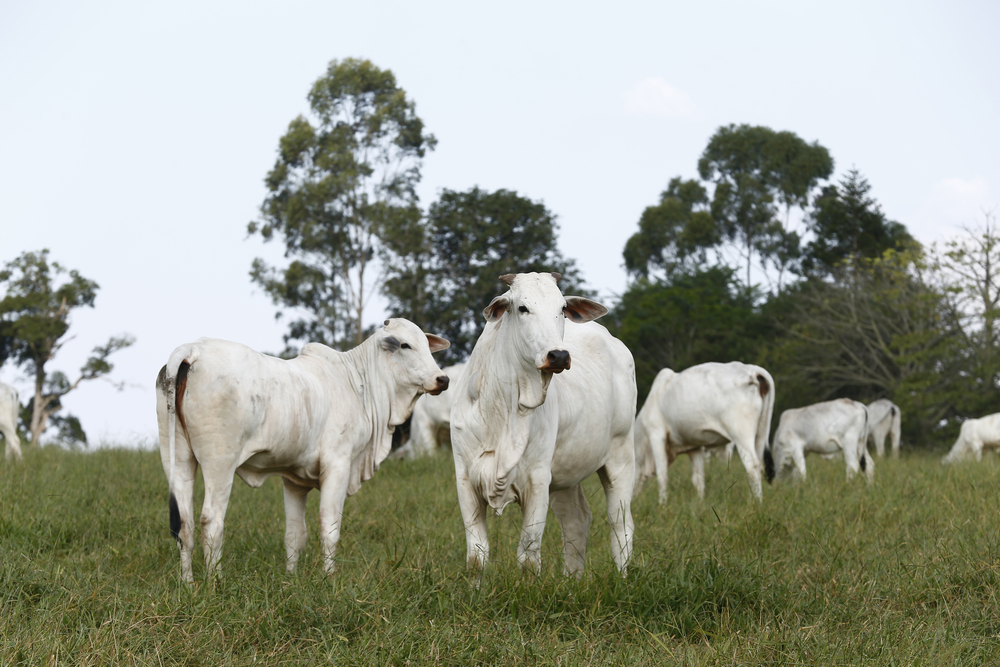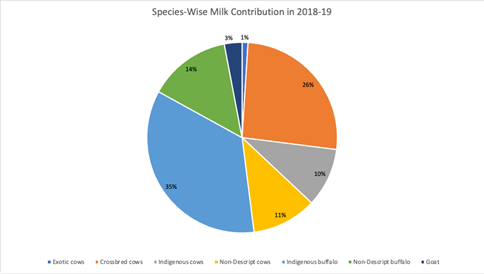
Dairy production and consumption in India can be dated back to the Vedic period. Historically, it can be traced to the first domestication of the Zebu cattle which is thought to have originated in the Indian subcontinent, dating back roughly 8,000 years. Dairy plays a significant part in numerous aspects of Indian society, including cuisine, religion, culture, and the economy. Value added dairy products like Paneer, Curd, Ghee etc. were important elements of food in the Indian subcontinent encompassing the food preferences of rulers hailing from different religious backgrounds.
While previously milk production in the country was limited to household farms, the introduction of 'Operation Flood' in the mid to late 20th century transformed the dairy sector. Presently, India has the highest level of milk production globally, with a total production of 198.4 Million Metric Tonnes (MMT) of which 50 per cent of the production can be attributed to buffaloes. Within India, the top five states contributed to about 54 per cent of the total milk production in 2019. The Indian state of Uttar Pradesh tops the list with a production of 30 MMT, followed by Rajasthan (23 MMT), Madhya Pradesh (16 MMT), Andhra Pradesh (15 MMT) and Gujarat (15 MMT). The Indian dairy industry is significant for the country on various accounts and currently provides employment opportunities to over 70 million farmers.
According to the data provided in the 2019 annual report published by the Department of Animal Husbandry and Dairying, India has 193.46 million cattle and 109.85 million buffaloes with a total bovine count of 303.76 million. The 2018-19 data suggests that indigenous cows have a milk yield of 3 kg/day/animal whereas cross bred cows exhibit a milk yield of 7.85 kg/day/animal.

Therefore, in order to further push the envelop for dairy production in India, breed improvement through cross breeding becomes the obvious need of the hour for the country. Even though cross breeding of cattle only received attention from policy makers by 1961, it had already started in India in 1875. With the intent to improve milk production, cross-breeding of indigenous breeds with exotic ones has been carried out extensively since 1965. Currently, there are three key methods for cross breeding in India, namely, In-vitro Fertilization (IVF), Embryo Transfer (ET) systems, and Artificial Insemination (AI). Out of the three mentioned procedures, AI and IVF are the most prevalent.
Dairy breeding improvement interventions combining AI using exotic semen with estrus synchronisation is a viable technology that is applied to improve milk production. It has been noted that states with higher presence of cross breed cows, such as in Kerala (9.9 kg/day/animal), Punjab (9.3 kg/day/animal) and Haryana (8.9 kg/day/animal) have exhibited higher productivity yields across the country.
Artificial Insemination
Artificial insemination is a globally accepted technique in which semen collected from a superior bull is introduced into the uterus to induce pregnancy at the time of heat.
In 2019, 75.6 million AI procedures have been performed leading to a 26 per cent penetration in India. While this is a major feat for the country, the government has ambitious targets of achieving 50 per cent AI penetration which would require 87 million additional AI procedures and setting up of 1,20,000 AI centres in the country. This presents a huge opportunity for growth and investment in the Indian dairy sector.
In Vitro Fertilization (IVF)
The process of IVF relies on the extraction of the oocyte (unfertilized egg) from the ovary of the donor female, which is then matured, fertilized and cultured in vitro (in the lab).
When the females are poor responders to superovulation treatments, IVF is proven to be advantageous over AI and ET procedures. The government of India has already sanctioned projects for the establishment of 30 IVF labs with 15 labs already operating.
Government Impetus
National Artificial Insemination Programme (NAIP)
On September 11, 2019, providing a boost to the cross-breeding procedures in the country, Prime Minster Narendra Modi, launched the first phase of the NAIP. Under the programme, every animal was assigned a 12-digit unique identification number under the Pashu Aadhar Scheme. This was done to ensure complete accuracy and monitoring till the birth of the calf, once AI is performed.
The second phase of the programme was initiated on August 1, 2020 covering 50,000 animals per district, with an allocation of INR 1,090 crore in 604 districts. Under the programme, 9.06 crore AI are to be performed which is expected to lead to the birth of 1.5 crore high yielding female calves.
National Dairy Plan Phase 1 (NDP-1)
The NDP-1 is an externally aided project with a total outlay of INR 2,242 crore with INR 282 crore share of End Implementation Agencies (EIAs) for the period 2011-12 to 2018-19. Under NDP-1, 14 Progeny Testing (PT), 9 Pedigree Selection (PS) and 5 Bull Production through Transfer of Imported Embryo (BPTIE) projects were implemented through various EIAs. This was done to produce the replacement requirement of High Genetic Merit (HGM) bulls.
Additionally, under the scheme 171 exotic bulls, imported from Germany and Denmark were allotted to different semen stations nationally and 28 semen stations were strengthened for the production of disease-free semen doses.
From April 2018 to November 2019, 12,558 villages through 1,367 mobile AI technicians and have carried out 1.21 million AI under the pilot project.
Rashtriya Gokul Mission (RGM)
Under RGM, an outlay of INR 300 crore has been provided for the next 5 years (2019-20 to 2023-24) and 14 PT and 7 PS projects have also been approved.
RGM and NDP-1 together aims to procure 4,157 genetically superior bulls.
Conclusion
The dairy industry is a key sector for the Indian economy. In April 2020, the government announced an allotment of INR 15,000 crores ($ 2.1 billion) under the Animal Husbandry Infrastructure Development Fund (AHIDF). This bears testimony to the unwavering support of the Indian government towards the sector. Following the clarion call for ‘Atma Nirbhar Bharat’ and ‘Vocal for Local’ introduced by Prime Minister Narendra Modi, the sector is further moving towards self-reliance by infusing technology within our traditional sectors.



